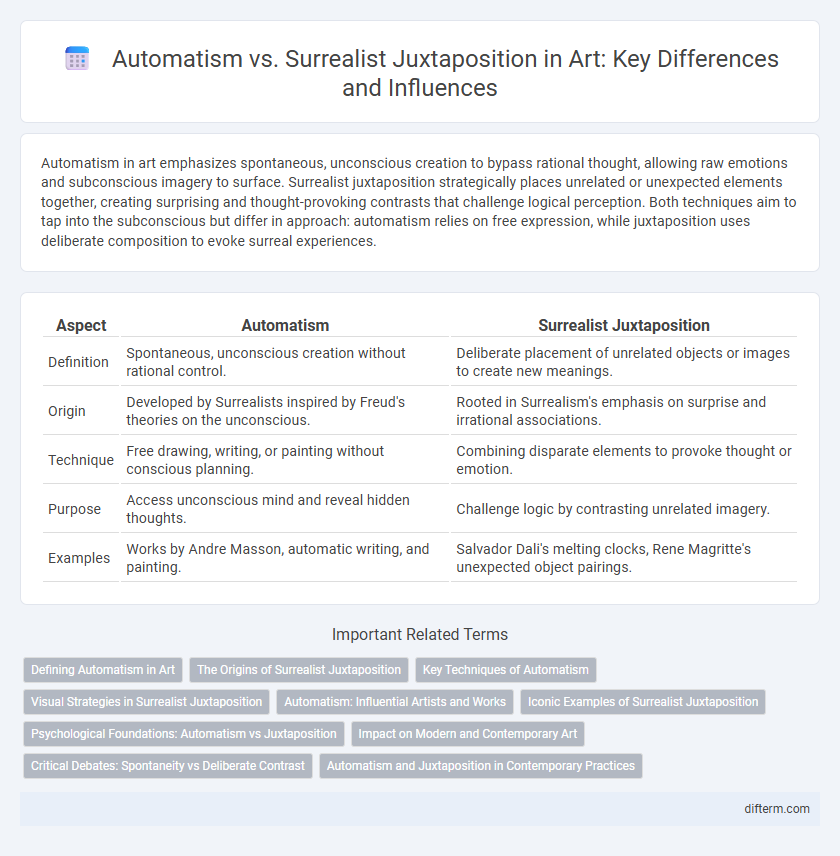Automatism in art emphasizes spontaneous, unconscious creation to bypass rational thought, allowing raw emotions and subconscious imagery to surface. Surrealist juxtaposition strategically places unrelated or unexpected elements together, creating surprising and thought-provoking contrasts that challenge logical perception. Both techniques aim to tap into the subconscious but differ in approach: automatism relies on free expression, while juxtaposition uses deliberate composition to evoke surreal experiences.
Table of Comparison
| Aspect | Automatism | Surrealist Juxtaposition |
|---|---|---|
| Definition | Spontaneous, unconscious creation without rational control. | Deliberate placement of unrelated objects or images to create new meanings. |
| Origin | Developed by Surrealists inspired by Freud's theories on the unconscious. | Rooted in Surrealism's emphasis on surprise and irrational associations. |
| Technique | Free drawing, writing, or painting without conscious planning. | Combining disparate elements to provoke thought or emotion. |
| Purpose | Access unconscious mind and reveal hidden thoughts. | Challenge logic by contrasting unrelated imagery. |
| Examples | Works by Andre Masson, automatic writing, and painting. | Salvador Dali's melting clocks, Rene Magritte's unexpected object pairings. |
Defining Automatism in Art
Automatism in art refers to the technique of creating without conscious control, allowing the subconscious mind to guide the artist's hand. This method often results in spontaneous, abstract forms that reveal hidden emotions and thoughts beyond rational interpretation. Unlike Surrealist juxtaposition, which relies on placing unexpected images side by side to provoke meaning, automatism prioritizes uncontrolled execution to access pure creative impulse.
The Origins of Surrealist Juxtaposition
Surrealist juxtaposition originated in the 1920s as artists sought to unlock unconscious creativity by placing unrelated objects or images side by side, provoking irrational connections and dream-like narratives. This technique contrasts with automatism, which relies on spontaneous, uncontrolled creation without preconceived structure, emphasizing free expression from the subconscious mind. The deliberate pairing in surrealist juxtaposition became a foundational method to challenge rational thought and explore surrealist themes of desire, fear, and the uncanny.
Key Techniques of Automatism
Automatism in art emphasizes spontaneous, subconscious creation through techniques like automatic drawing, free association, and gesture-based mark-making. This approach removes conscious control to reveal unfiltered emotions and thoughts, contrasting with Surrealist juxtaposition, which relies on the deliberate placement of unrelated objects or images to create unexpected meanings. Key automatism methods enable artists to access the psyche directly, fostering originality and psychological depth in artworks.
Visual Strategies in Surrealist Juxtaposition
Surrealist juxtaposition employs visual strategies that combine unrelated images to evoke subconscious associations and challenge rational perception. This technique contrasts with automatism by intentionally placing disparate elements side by side to create surprising, dream-like narratives. Masterful use of scale, color, and spatial relationships intensifies the uncanny effect central to surrealist visual language.
Automatism: Influential Artists and Works
Automatism, a key technique in Surrealist art, emphasizes spontaneous creation without conscious control, profoundly influencing artists like Andre Masson and Joan Miro. Masson's "Automatic Drawing" series exemplifies this approach, featuring fluid lines and abstract forms that bypass rational intent. Joan Miro's works, such as "The Harlequin's Carnival," embody automatism through dreamlike imagery and subconscious expression.
Iconic Examples of Surrealist Juxtaposition
Iconic examples of surrealist juxtaposition include Salvador Dali's "The Persistence of Memory," where melting clocks contrast with a desolate landscape, and Rene Magritte's "The Son of Man," featuring a man's obscured face by a hovering green apple. These works highlight the deliberate placement of incongruous elements to provoke unexpected interpretations. Surrealist juxtaposition emphasizes the irrational fusion of objects to challenge conscious perception and evoke subconscious insights.
Psychological Foundations: Automatism vs Juxtaposition
Automatism in art emphasizes the psychological foundation of accessing the subconscious mind through spontaneous, uncontrolled creation, often linked to Freudian theories of free association and dream analysis. Surrealist juxtaposition relies on the deliberate combination of disparate, often contradictory imagery to provoke unconscious connections and challenge rational thought, reflecting Jungian concepts of archetypes and the collective unconscious. Both techniques explore the depths of the psyche but differ in process--automatism foregrounds unconscious spontaneity, while juxtaposition involves conscious, symbolic arrangement.
Impact on Modern and Contemporary Art
Automatism revolutionized modern art by emphasizing spontaneous, subconscious creation, influencing Abstract Expressionism and pushing artists towards uninhibited self-expression. Surrealist juxtaposition introduced unexpected, dreamlike combinations that challenged conventional perceptions and inspired contemporary mixed-media and conceptual art practices. Both techniques fundamentally shaped the trajectory of 20th and 21st-century art by expanding the boundaries of creativity and narrative.
Critical Debates: Spontaneity vs Deliberate Contrast
Automatism in art emphasizes spontaneous, subconscious creation, allowing unfiltered expression free from rational control, while Surrealist Juxtaposition relies on deliberate contrast between unexpected elements to evoke surprise and deeper meaning. Critical debates often focus on whether true creativity stems from uninhibited spontaneity or from intentional composition designed to challenge perception. These opposing approaches reflect broader tensions within Surrealism regarding the balance between the unconscious mind's raw impulses and conscious artistic intervention.
Automatism and Juxtaposition in Contemporary Practices
Automatism in contemporary art emphasizes spontaneous, unpremeditated creation, enabling artists to bypass conscious control and tap into the subconscious mind. Surrealist juxtaposition involves placing disparate images or symbols side-by-side to evoke new meanings and challenge rational interpretation. Both approaches remain vital in current practices, blending intuitive processes with strategic contrasts to expand expressive possibilities.
Automatism vs Surrealist Juxtaposition Infographic

 difterm.com
difterm.com